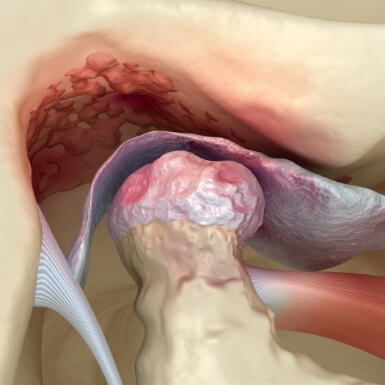TMJ Treatment – Aspen Hill, MD
Make the Pain Go & Stay Away
An estimated 10 million Americans experience daily symptoms like jaw, head, face, neck, and ear pain and don’t know why. Many have even visited doctors and still don’t have answers. For these people, the culprit is often temporomandibular joint disorder (TMD). If you’re in this situation and have never heard of TMD before, learning about it could finally lead to the lasting solution (and relief!) you’ve been searching for. Keep reading to learn more about the options for TMJ treatment at our Aspen Hill, MD specialty dental office.
What is TMJ/TMD?

If you wiggle your mouth from side to side, you’ll feel two little hinges in front of your ears. Those make up your TMJ, or temporomandibular joint. This is what allows your mouth to move so you can speak, chew, yawn, and laugh. Like other joints in the body, it can develop problems due to strain or injury. But, with TMD, another factor is at play—a misaligned bite, in that the teeth and the resting position of the jaw don’t line up.
Symptoms of TMJ Disorder

Because the jaw, head, and neck are deeply interconnected with nerves and muscles, a problem in one area can easily affect the others. That’s why TMD sufferers often experience jaw and face pain as well as headaches/migraines or even ear and neck pain. Even though they might not seem related, they can be! TMD can also develop or even cause other conditions like sleep apnea and bruxism, which is unconscious teeth grinding and jaw clenching while sleeping.
Headaches & Migraines Ear & Neck Pain Face & Jaw Pain
Diagnosing TMJ Disorder

What kind of doctor has the right qualifications to diagnose TMD? A dentist, actually, but only one who has undergone special training so they can spot the physical signs of the condition. With Dr. Saba, she’ll use a combination of her expert eyes and the latest technology to determine exactly where your pain is coming from so she can treat it directly.
Learn More About How TMJ is Diagnosed
Treating TMJ/TMD

Thankfully, treating TMD is relatively simple for most people. The bite can be rebalanced by slightly adjusting the teeth, which will take the strain off the joint. An oral appliance can also stop persistent teeth grinding while helping the jaw find a new and more relaxed resting position. And, with options like the TENS machine and Botox injections, Dr. Saba can make the pain go away quickly so a patient can be comfortable while a more long-term solution is taking effect.
Learn More About How TMJ is Treated
TMJ Treatment FAQs

Do you have questions about TMJ disorder or how to treat it? Our team is always happy to answer any questions you may have to make sure that you’re making the best decisions for your oral health. Below, we’ve compiled a list of some of the most frequently asked questions we receive from our patients. If you still don’t see what you’re looking for, please give us a call to speak with one of our knowledgeable staff members.
Is it possible to cure TMJD permanently?
There are several treatments that are designed to provide temporary relief for symptoms of TMJD, like BOTOX and TENS machine treatment. These can help make your condition more bearable in your day-to-day life. However, other treatment options, like occlusal adjustments/equilibration, prolonged use of an occlusal splint, or orthodontic treatment have the potential to provide you with permanent relief from your symptoms by addressing the underlying problem causing them.
Is BOTOX for TMJ safe?
When administered at the correct dosage by an experienced TMJD provider, like Dr. Saba, BOTOX is considered to be completely safe. While there are possible side-effects, like some nausea, redness and bruising, or headaches, it’s very rare for them to be serious. If you have concerns you’d like to discuss, please don’t hesitate to ask our team!
How long does it take for an occlusal splint to treat TMJD?
Occlusal splints are mouthguard-like appliances that you’ll need to wear before you go to bed each night. Over time, you’ll notice that your symptoms will decrease, but this won’t just happen immediately. After several weeks, many patients experience major improvements, but not complete relief. Between three and six months, patients typically report that their occlusal splint has helped resolve their TMJD discomfort.
It's important to keep in mind that everyone is different, and your journey may be longer or shorter than the average person’s!
Can I treat my TMJD without surgery?
Yes! In fact, at Exceptional Dentistry Pain & Sleep Solutions, we specialize in non-surgical treatments for TMJD. We understand that jaw surgeries can be huge commitments and require long recovery times, which is why we offer both pain-management and long-term solutions. Each of the options that we offer are minimally or non-invasive.
Is TMJ treatment expensive?
While TMJ treatment can be costly, our team will help you navigate the financial aspect without added stress. We take pride in offering transparent and honest cost estimates, so if you have any concerns or questions about yours, please never hesitate to ask us. We also work with several trusted third-party financers, like CareCredit, LendingClub, and Sunbit, to give you the option of making small monthly payments, as well as complimentary head and neck pain evaluations.
Is TMJ treatment safe?
It’s natural to wonder whether the treatments required to resolve your TMJ problems cause any harmful side effects or complications. Fortunately, the services we offer are considered completely safe when performed by a qualified professional. Although it can depend on your provider, typically many experts prefer to recommend minimally invasive methods, first. For example, Dr. Saba focuses on medication and surgery-free solutions because invasive procedures always come with potential complications. By avoiding this risk, she can safely address your jaw pain without causing any other issues. An oral appliance or BOTOX injections might be all that you need to allow your joints to relax and heal.
How long does TMJ treatment take?
There is no single answer to this question because it depends on your unique circumstances. The severity of your condition and the chosen treatments can all impact your total timeline. While it’s possible for some at-home jaw exercises to provide some immediate, but temporary, relief, typically you’ll require professional assistance for long-term resolutions.
If you’d like an idea of what you to expect, some typical solutions and time commitments are outlined below:
- Occlusal splints: Wearing a splint every night for a few weeks to several months can alleviate symptoms, but there’s a possibility that you’ll need to wear it ongoing.
- Equilibrations/ Occlusal adjustment: Depending on what needs to be done (whether enamel must be removed or built up), you may notice an improvement within a few days or a few weeks.
- TENS machine: “Transcutaneous electrical nerve stimulation” creates an almost immediate sense of relief. The machine pulses trigger the release of endorphins which are your body’s natural painkillers. However, this doesn’t necessarily fix the underlying cause so the issues will likely return.
- BOTOX injections: It usually takes about 30 minutes to complete the injection, but then you may have to wait a day or two before you notice a decrease in your levels of discomfort.
Is TMJ treatment covered by insurance?
There’s a possibility that the services required to address your TMJ will be covered by medical or dental insurance, but it depends on the severity of your condition, the treatment being performed, and your insurance policies. The regulations around covering TMJ resolutions can be complex and vary from state to state as well as for different types of plans.
Some insurance providers specifically exclude these methods while others stipulate that only a specific dollar amount can be spent on them. Others only cover surgical procedures while some also include oral appliances. It’s always wise to check with your insurance plans to find out exactly what’s covered. If you’re not sure, you’re welcome to ask our friendly office staff for assistance. They’re happy to help you work through the details to maximize the benefits available to you.
Does occlusal adjustment for TMJ hurt?
Occlusal adjustments refer to making changes to the biting surfaces of your teeth to allow them to come together properly when you close your mouth. Regardless of the procedures involved, Dr. Saba will work to ensure that you remain comfortable the entire time. Whether she’s applying composite resin to build up the length of your teeth or is carefully removing a small amount of enamel to even them out, she’ll be sure to numb the area first with a local anesthetic. You might experience mild throbbing for a few days afterward, but it should be temporary and dissipate relatively quickly.
